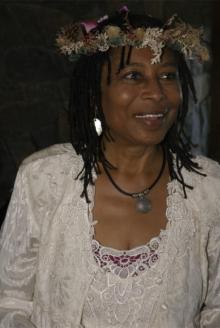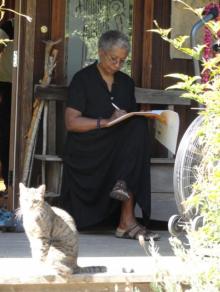- Home
- Alice Walker
Anything We Love Can Be Saved Page 11
Anything We Love Can Be Saved Read online
Page 11
for everything flowers, from within, of self-blessing;
though sometimes it is necessary
to reteach a thing its loveliness,
to put a hand on the brow
of the flower,
and retell it in words and in touch,
it is lovely
until it flowers again from within, of self-blessing*
Standing near my house, in a forest that was once ravaged by poorly paid loggers intent on making a profit for rich thieves who do not respect the planet, and finding it still, in its ravaged, struggling-to-recover state, miraculous, I send a prayer to my brothers: that you continue to open to each other and to bless yourselves. Continue to let go of fear. Continue to insist on truth and trust. Our time is short on this earth, but that it can be rich and joyous in spite of oppression, white madness, and black confusion is undeniable. Be each other’s “hand on the brow.” Don’t miss your time.
* The Student Nonviolent Coordinating Committee, a student civil rights organization of the 1960s.
* I first encountered this poem in Sharon Salzberg’s wonderful book Lovingkindness: The Revolutionary Art of Happiness. The lines are from “St. Francis and the Sow,” by Galway Kinnell.
PART FOUR
Turquoise and Coral
Turquoise and Coral
THE WRITING OF
THE TEMPLE OF MY FAMILIAR
Painting My Own Door
One day in Mendocino in 1983 I was invited to the home of a casual acquaintance who knew of my interest in Indian art. For sale, spread across her yard, were many items from Guatemala: jewelry, fabrics, clothing, beaded gourds, musical instruments. They were being sold by a Guatemalan man and his North American wife, who said that the money they earned would go to the people from whom they had received the goods: Indians who had been chased from their homes and villages by a Spanish-speaking army led by non-Indians.
There were many old and rare pieces of clothing which looked as if they’d just come off someone’s back. I bought one of these, a lovely, well-used shawl of many colors, and an old piece of red-and-blue handwoven cotton, very faded and with a number of holes. This cloth, the North American woman assured me, was practically extinct in Guatemala and was not being made anymore. I liked its colors, its softness. What had it been in its Guatemalan life, I wondered. A tablecloth? A bedspread? For it was large, I saw as I unfolded it beneath the trees prior to purchase. There were curious seams running through it and, along one side, a hem. It had a quality I particularly like—in people as well as in fabric—suppleness and strength.
It was months later, after I had earned enough money to build an indoor toilet onto my studio, that I noticed there were words (actually one word, printed over and over) written on the cloth. I was sitting in the shade on the front deck, making a pair of curtains for the new bathroom (for I had decided to splurge and have a bathtub as well). I held the cloth up to the sun and tried to read it, only to find that the word was in Spanish. Well, my daughter, Rebecca, studied Spanish in school and was practically fluent; I called her immediately and spelled the word for her. It meant “Remember.”
Well, yes, I thought, but what am I to remember?
I completed the curtains, hung them at the windows, stroked them often as I passed by, and now the word “Recuerda” (which I now saw was only the first half of a much longer word, which Rebecca and I loosely translated as “You all remember!”) stood out with all the clarity and impact of a stop sign. I was to remember; I knew that much; and part of what I had to remember, I soon realized, was the condition and fate of the people, women, surely, who had made the cloth.
For years my partner, Robert, and I had planned to study Spanish. Rebecca supported and encouraged us. In the fall of 1986, just at the start of the rainy season, we began classes, tutored by Rebecca’s own high school Spanish teacher, Joanna. Each Tuesday morning promptly at ten o’clock she arrived, and we sat around my dining-room table as Robert and I made a valiant attempt to learn Spanish. This continued for five months. I was remarkably slow to learn. Robert, who once spent a summer constructing housing on the outskirts of Havana, was much quicker. I found Spanish as difficult to learn and to speak as it was beautiful to hear—and not at all “easy,” as my sister students at Spelman College used to tell me it was when I moaned and groaned over the French I had then chosen to study, and have since forgotten.
However, the Spanish-speaking characters in The Temple of My Familiar didn’t wait for me to attain proficiency in their tongue. Lucky for me. Almost immediately, after only the second or third lesson—at a time when I barely grasped Joanna’s cheery greeting each Tuesday morning of “¡Hola! ¿Como está?”—they began speaking, as if I understood every word. Which I did, because though I realized they were speaking in Spanish, I was now able to hear it in English! Usually, now, by the time Joanna arrived at ten, I would have been writing the story involving my Spanish-speaking characters since about seven. I would leap out of bed minutes before her knock and hasten into my clothes and down the stairs to dutifully perform, with Roberto, the day’s dialogo. I felt at times exasperated that when I opened my mouth, the silvery Spanish sounds coiled just beneath my tongue that I had been immersed in for three hours failed to roll out. Joanna, witnessing my look of surprised perplexity, would often laugh.
At the same time that I was learning Spanish—in order to be able to more accurately “remember” the women of the cloth—I began to dream about, to think about, and to desire to see around me the colors turquoise and coral.* I developed such a fixation on these colors, which I called my “spiritual colors,” and I talked so much about needing them—though it was unclear to me in just what way I needed them—that on my fortieth birthday, as we sat down to a surprise dinner for me in our rented house in Ubud, Bali, Rebecca and Robert presented me with a very old, lovely East Indian necklace made of turquoise and coral. It was beautiful. I loved it. I put it on. But I needed something more.
Back in the States I bought coral-colored bedsheets, a coral-and-turquoise lampshade. A coral dress. Turquoise boots. But none of these things helped. I still yearned for these two colors, but not necessarily, I soon realized, to decorate my house with or to wear.
I felt apprehensive too. Sometimes, when I thought about the persistence of these colors in my psyche, my need for them seemed irrational, and made me think of the local women when I was growing up, who developed, usually while pregnant, a passion for starch or white clay, which they sucked on by the hour.
One day I overcame my apprehension enough to buy several gallons of turquoise and coral paint. The woman working on the bathroom painted the bathtub turquoise but balked at painting the walls coral. Too hot, she said. And I was cowed again. However, months later, I went out to the shed and pulled out the paint I had bought. The turquoise was too dark, I found, and the coral too orange. I sat down and began to mix these colors with others—the orange coral I mixed with brown, and the dark turquoise I mixed with white, until I reached the colors I’d held so long in my mind. I then began to paint my bed turquoise and the ceiling above my bed coral. I began to paint my front door.
I felt immediately that this was the right thing to do, and went ahead and painted the bed and the ceiling in a matter of hours, giving myself such a painful case of tendonitis in shoulder and wrist that the door was left half done—for nearly a year. Painting my bed and ceiling in turquoise and coral, however, unlocked the central dream of The Temple of My Familiar, the dream about our collusion with the forces that suppress and colonize our spirituality. I saw that our essential “familiar” is our own natural, untamed, “wild” spirit and that its temple is the cosmos, that is, freedom. This dream came complete with temple, familiar, Lissie and Suwelo, and the understanding that I was writing a “romance” (that is to say, a wisdom tale, memory, adventure) that was less about the relationships of human beings to each other than about the relationship of humans (women, in particular) to animals, who, in the outer world, symbolize w
oman’s inner spirit.
This insight was confirmed by the fact that animals—whether I was in the country or the city—were suddenly everywhere in my life. A “watch cat” appeared on my stoop in the city and remained there until the novel was done; various other creatures (birds, deer, snakes, etc.) were constant visitors in the country. The presence of these numerous animals seemed so odd to me, but in an entirely lovely way, that I wrote an essay about the experience, called “The Universe Responds.” It seemed to me that the animals I now saw wherever I looked—much like the Spanish-speaking characters who showed up talking at the moment I started to learn Spanish—had decided to wait until it was clear whether I had eyes to see, and then had decided to let themselves be seen.
There is a third “leg” on which the pot of this novel rests. It was something that occurred a few months after I’d finished The Color Purple and was missing the characters in that book dreadfully. Are there to be no more such fascinating folks in my life? I inwardly mumbled. As I thought about this one day on my way to put a bundle of trash into the outdoor garbage can, I suddenly flashed on an old man in a nursing home and a younger, middle-aged man sitting beside his bed. There was an intensity between them that stopped me in my tracks, and a vividness to the image that made it memorable. I found I was able to recall it, and puzzle over it, clearly and frequently, over the next several years. It was not until I reached the last chapter of The Temple of My Familiar, however, that I understood that the old man was Hal and the younger man Suwelo, and that Hal had been instructing Suwelo about how to live—with women, with children, with other men, with animals, with white people. ¡Con todos!
Throughout the writing of Temple I relied on the guidance provided by the synchronicity I experienced between my dreams, insights, and intuitions and events that corroborated or resonated with them in the world. For example, six months or so after I’d written the chapters about the Latin American refugees, Zedé and Carlotta, I met three refugees—a mother and her two young daughters—from El Salvador. I met them at a political demonstration, and for nearly two months they lived in my house with me. We are friends today and I love them all for who they are, but on first meeting, I have to admit, they were the mother and daughter, Zedé and Carlotta, I had created in the opening chapters of my novel, and I responded to them with the instant recognition of someone who already understood something of their lives. It was as if, having written about a refugee family—Zedé and Carlotta—I could now see Marcia and her daughters, Maria and Daniela,* and they were not, even from the first moment, strangers to me.
I cannot recount or even remember all the times I said to Rebecca or Robert, “Wait till you read my novel!” as some confirmation or other from the Universe appeared. Near the end of writing it, I felt as if I were walking in a circle of magic, and this made me indescribably happy. But nothing could have prepared me for the “magic” that occurred on the very last day of writing. I had just completed the paragraph in which Suwelo contemplates the painting of Lissie as Lion, and was hurrying up the hill to my studio to type it up on my Mac Plus, when I noticed what appeared to be a tan plastic dry cleaner’s bag—without my glasses this was a blur—lying some distance out in the field. A neatnik to my soul—I will pick up trash anywhere—I moved quickly to remove this unsightly object, wondering all the while how it came to be there. But then, when I was a few steps away, I saw that it wasn’t a discarded dry cleaner’s bag but a large, tawny cat, a miniature “lion,” lying at ease, calmly looking back at me. I’d never seen it before; I haven’t seen it since. I began to smile and fairly skipped along to my studio.
I felt that this “omen” was Lissie’s sign of approval for the ending I’d just written, and also a sign from the animals that in The Temple of My Familiar I had kept to our collective vision of reality. And that we were united in our sense of peace at the outcome.
And, finally, after the novel was finished in manuscript, I discovered I was ready to complete the painting of my front door, which I had started nearly a year earlier when I painted my ceiling and my bed. Rolling up my sleeves one morning, paintbrush in hand—and only just then realizing I’d written a book in which many of the characters are painters!—I began.
My door is coral and turquoise, trimmed in dark lavender blue. There is a sun on it and a moon, and the lower turquoise panels look like ocean and the upper ones look like sky. There are two birds flying at the very top. There are snakes left and right.
This is the door to my dwelling. It says: This is the person who lives in this house now.
I look at it, and it is very satisfying to me, though my snakes are awkwardly drawn and my birds are smudged.
Maybe I am mistaken, I think, looking at it, in believing that it was painting with my “spiritual colors,” turquoise and coral, that allowed me to write my novel. Perhaps it was writing my novel that permitted me, at last, to paint and therefore to recognize my own door.
POSTSCRIPT: On February 2, 1989, I received the bound reader’s copy of The Temple of My Familiar, with its dreadlocked lion in one red slipper on the cover.
That night, a chunky raccoon appeared at my back door and looked in on a friend and me as we were finishing supper. We dropped to hands and knees and “talked” to it through the glass, hardly believing what we saw. This was, after all, the back door of my house in the city, which is surrounded not by forest but by other houses and fenced-in backyards, and is in the heart of San Francisco.
* The “coral” I had in mind was not bright red but rather a faded terra-cotta. I thought of it as coral because of the many pieces of coral I’d collected over the years that were that color.
* Not their real names.
Looking for Jung
WRITING POSSESSING THE SECRET OF JOY
In the spring of 1990 my Dutch publisher invited me to Amsterdam. My novel The Temple of My Familiar had recently appeared in Holland and I agreed to do a number of signings and readings. A strong motive for going to Amsterdam, which I was delighted to find I liked, was its proximity to Switzerland. One day near the end of our stay in Amsterdam my companion, Robert Allen, and I flew to Zurich and dropped by the C. G. Jung Institute for directions on how to get to Jung’s summer retreat at Bollingen, on the shores of Lake Zurich.
We traveled light, as we often do, absorbed in the journey, open to what we always expect will be interesting events. On this trip, as on so many others, we were not disappointed. Though at first no one we encountered at the institute seemed to know a thing about the whereabouts of Bollingen and seemed somewhat surprised we’d want to know how to get there—two middle-aged, dread-locked hippies from the United States, reggae singers, for all they knew—we were not daunted, but decided to wander about the garden to see what flowers the institute had. As we walked away, however, we were flagged by a small blond woman who introduced herself as Susan, and who exclaimed, when I told her my name, that she and her study group had finished reading The Temple of My Familiar just the week before. She stared in disbelief that I should be standing there, in Zurich, on the grounds of the Jung Institute. Robert and I laughed at her surprise. After all, we said, as a student of Jung, she should know a thing or two about synchronicity!
Susan was an American who’d been living in Switzerland and studying at the institute for a couple of years. We told her that we wanted to visit Jung’s tower-house in Bollingen and that we had only one day to do it in; we had a return flight to Amsterdam the same day. She looked skeptical but immediately told us which train to catch; then, thinking of how fast we’d have to move to get there and back, she decided to come with us and put us on the train herself.
We dashed to the train station, Susan bought our tickets, and within minutes we were on our way, her serious reservations about whether we’d get anywhere near Jung’s house ringing in our ears. She had said no one lived there; that the place was behind a high wire fence and a gate that was kept padlocked. Jung’s son or grandson sometimes used it, she thought, but she herself ha
d gone to Bollingen on several occasions and had not been able to get in. It was clear she didn’t think we’d have much luck getting inside either; it was just as clear she was delighted to help us try.
Since we were on the train, going in the right direction, Robert and I happily settled down to enjoy the ride. Once, we had to change trains, unexpectedly, and encountered a group of Peruvian Indians playing flutes under a bridge. We were so glad to see them, gentle people of color from our own continent, that we might have stayed to listen all afternoon and missed the train to Bollingen. But we made it, and in due course found ourselves somewhere beyond our destination, with the train’s conductor telling us we’d have to get off someplace we’d never heard of and walk back.
The town we came to was tiny, but every little restaurant in it seemed to be preparing lunch. We realized we were hungry. After a leisurely meal we sat in the town square admiring the mountains, massive foothills of the Alps, and the lake, its blue edge rimmed by rustling cattails and whispering willows. Pretty soon a new gold-colored Mercedes arrived. A native—florid, flaxen, fifty—leaned from it and said he was the taxi. Would we like to go somewhere? We said we’d like to go to Bollingen. He said, “Get in.” We did. Where in Bollingen would we like to go? “Jung’s place,” we said. He thought he knew where that was, he said. Off we went.
Fifteen minutes later we were passing a large barn in a rolling landscape studded with cows. On a dirt road that runs parallel to the lake we met a tall, elderly, white-haired man who appeared out of nowhere and caused me to do a double take. Our driver waved at him, the elderly man hoisted his pipe in response, and we sped on down the road. Robert and I held hands tightly, not knowing what to expect. We remembered Susan’s warning that the high wire gate was always locked. That on not one of her journeys over a two-year period had she been able to get inside.

 In Search of Our Mothers' Gardens: Prose
In Search of Our Mothers' Gardens: Prose In Love and Trouble: Stories of Black Women: Stories of Black Women
In Love and Trouble: Stories of Black Women: Stories of Black Women Anything We Love Can Be Saved
Anything We Love Can Be Saved The Color Purple
The Color Purple By the Light of My Father's Smile
By the Light of My Father's Smile The Third Life of Grange Copeland
The Third Life of Grange Copeland You Can't Keep a Good Woman Down
You Can't Keep a Good Woman Down The Temple of My Familiar
The Temple of My Familiar Possessing the Secret of Joy
Possessing the Secret of Joy We Are the Ones We Have Been Waiting For
We Are the Ones We Have Been Waiting For The Way Forward Is With a Broken Heart
The Way Forward Is With a Broken Heart Meridian
Meridian Revolutionary Petunias
Revolutionary Petunias A Poem Traveled Down My Arm
A Poem Traveled Down My Arm Once
Once Horses Make a Landscape Look More Beautiful
Horses Make a Landscape Look More Beautiful Living by the Word
Living by the Word In Love and Trouble
In Love and Trouble The Color Purple Collection
The Color Purple Collection Now Is the Time to Open Your Heart
Now Is the Time to Open Your Heart Color Purple Collection
Color Purple Collection Taking the Arrow Out of the Heart
Taking the Arrow Out of the Heart The World Will Follow Joy
The World Will Follow Joy Meridian (1976)
Meridian (1976) Absolute Trust in the Goodness of the Earth
Absolute Trust in the Goodness of the Earth In Search of Our Mothers' Gardens
In Search of Our Mothers' Gardens